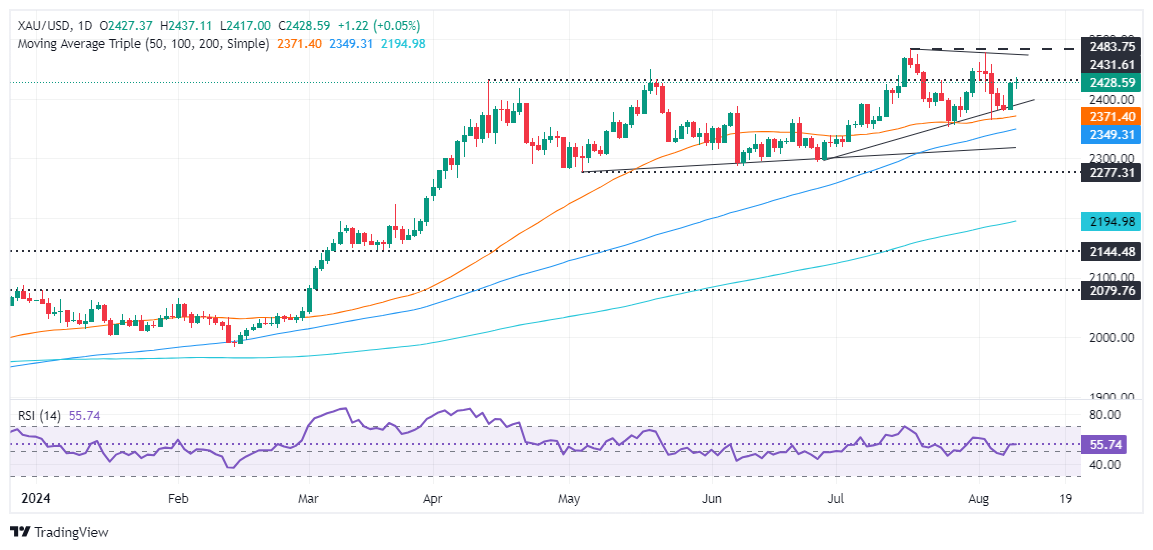Gold prices jump on geopolitical tensions ahead of US CPI
- Gold surges 1% as US Treasury yields retreat ahead of key CPI data, with the 10-year yield down to 3.902%.
- Ongoing tensions in the Middle East, with no ceasefire in sight, drive demand for Gold’s safe-haven status.
- Traders await critical US inflation and Retail Sales reports with Fed commentary signaling cautious optimism on disinflation.
Gold price rallied over 1% on Monday during the mid-North American session as US Treasury bond yields retreated ahead of a busy economic calendar in the United States. Traders are bracing for the latest Consumer Price Index (CPI) report for July, which is expected to show an improvement in the disinflation process. The XAU/USD trades at $2,467 after bouncing off a daily low of $2,423.
Sentiment shifted sour amid ongoing developments in the Middle East. Israel, Lebanon and Iran's lack of efforts to reach a ceasefire agreement kept market participants uneasy. This triggered a flight to Gold’s safe-haven status due to a possible escalation of the conflict.
US Treasury bond yields edged lower with the 10-year benchmark note rate down four basis points (bps) to 3.902%, ahead of the release of inflation data.
In the meantime, Federal Reserve Governor Michele Bowman was neutral, contrary to her usual hawkish posture and said that some progress on inflation is welcome, according to data from the last two months.
During the week, the economic docket will feature the release of US inflation figures on Tuesday and Wednesday, followed by Retail Sales data on Thursday and Friday’s University of Michigan (UoM) Consumer Sentiment.
Daily digest market movers: Gold price soars ahead of US data release
- July’s Producer Price Index is expected to drop from 0.2% to 0.1% MoM.
- The Consumer Price Index (CPI) is estimated to drop from 3% YoY to 2.9%; core CPI is expected to continue its downtrend from 3.3% to 3.2% YoY.
- Economists expect a jump in US Retail Sales from 0% to 0.3% MoM.
- The golden metal price gathered traction despite reports that China’s central bank restrained itself from purchasing Gold for the third consecutive month.
- The CME FedWatch Tool shows the odds of a 50-basis-point interest rate cut by the Fed at the September meeting at 47.5%, down from 52.5% last Friday.
Technical analysis: Gold price advances past $2,450
Gold’s uptrend extended on Monday, with prices approaching the $2,470 figure ahead of the all-time high (ATH) of $2,483, which could be tested if inflation comes lower than foreseen. Momentum favors buyers, as reflected by the Relative Strength Index (RSI), which is above the neutral line aiming higher.
The buyer's first resistance would be the ATH. Once cleared, the next challenge would be to clear the psychological figure of $2,500. Further gains are seen above that level, with $2,550 being next, followed by $2,600.
Conversely, if XAU/USD drops below $2,450, the next support would be $2,400, followed by the 50-day Simple Moving Average (SMA) at $2,373. Once surpassed, the decline could intensify, leading to the 100-day SMA at $2,352, followed by a support trendline around $2,320.

Gold FAQs
Gold has played a key role in human’s history as it has been widely used as a store of value and medium of exchange. Currently, apart from its shine and usage for jewelry, the precious metal is widely seen as a safe-haven asset, meaning that it is considered a good investment during turbulent times. Gold is also widely seen as a hedge against inflation and against depreciating currencies as it doesn’t rely on any specific issuer or government.
Central banks are the biggest Gold holders. In their aim to support their currencies in turbulent times, central banks tend to diversify their reserves and buy Gold to improve the perceived strength of the economy and the currency. High Gold reserves can be a source of trust for a country’s solvency. Central banks added 1,136 tonnes of Gold worth around $70 billion to their reserves in 2022, according to data from the World Gold Council. This is the highest yearly purchase since records began. Central banks from emerging economies such as China, India and Turkey are quickly increasing their Gold reserves.
Gold has an inverse correlation with the US Dollar and US Treasuries, which are both major reserve and safe-haven assets. When the Dollar depreciates, Gold tends to rise, enabling investors and central banks to diversify their assets in turbulent times. Gold is also inversely correlated with risk assets. A rally in the stock market tends to weaken Gold price, while sell-offs in riskier markets tend to favor the precious metal.
The price can move due to a wide range of factors. Geopolitical instability or fears of a deep recession can quickly make Gold price escalate due to its safe-haven status. As a yield-less asset, Gold tends to rise with lower interest rates, while higher cost of money usually weighs down on the yellow metal. Still, most moves depend on how the US Dollar (USD) behaves as the asset is priced in dollars (XAU/USD). A strong Dollar tends to keep the price of Gold controlled, whereas a weaker Dollar is likely to push Gold prices up.